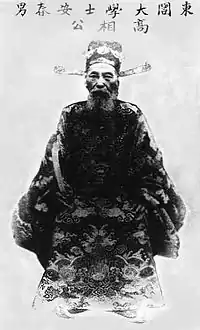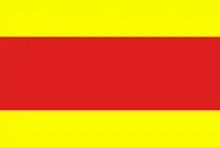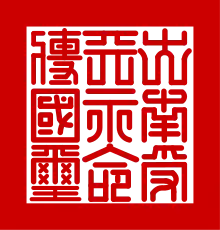
Cao Xuân Dục (chữ Hán: 高春育; 1843–1923) was a scholar, historian-mandarin, and court adviser in the Nguyễn dynasty, Vietnam.[1]
History
Cao Xuân Dục was born in Thịnh Mỹ, Diễn Châu, Nghệ An. In 1876, he entered Vietnamese Imperial examination and was awarded the degree of provincial graduate (舉人 - cử nhân), in the same class with the famous anti-French patriot Phan Đình Phùng from Hà Tĩnh.
He served under the Nguyễn Emperors Đồng Khánh and Thành Thái and held several important government posts including Governor-General of Hưng Yên (1889) and minister of education (1907).[2] He was one of the four top advisers to the Emperor during the Vietnam-France conflict in the early 20th century.
When Trương Như Cương (張如岡), a pro-French collaborator, coerced his colleagues to sign a petition to the Thành Thái Emperor to promote him to the position of viceroy (副王, Phó vương), Cao Xuân Dục refused to sign - instead he wrote a quick poem on the petition.
| Classical Chinese | Vietnamese transliteration | Vietnamese | English |
|---|---|---|---|
| 天無二日 國無兩王 臣高春育 不可記 | Thiên vô nhị nhật Quốc vô lưỡng vương Thần Cao Xuân Dục Bất khả ký |
Trời không có hai mặt trời Nước không có hai vua Thần Cao Xuân Dục Không thể ký |
The sky cannot have two suns. A nation cannot have two kings. Your servant Cao Xuân Dục, cannot sign. |
Because of that, he was demoted to be the prefect and district magistrate of Quốc Oai district, Hoàng Xá prefecture outside of Hanoi.
A relief of Cao Xuân Dục was sculptured on a wall in a cave in this local region to commemorate his righteousness.[3]
Cao Xuân Dục retired in 1913 to concentrate on building his library, Long Cương Bảo Tàng Thư Viện (named after his pseudonym), collecting and maintaining Vietnamese literature.
A street in Ho Chi Minh City was named after Cao Xuân Dục[4]
Writings
Cao Xuân Dục made significant contribution in maintaining Vietnamese culture and literature in 19th and 20th century.[5] He spent many years writing, collecting, copying, re-writing and preserving valuable books including:
- Annals of Đại Nam
- Quốc triều chính biên toát yếu
- Quốc triều khoa bảng lục - records of biographies of graduates of major imperial exams
See also
Notes
- ↑ Bradley Camp Davis, States of banditry: The Nguyen government, bandit rule, and the culture of power in the post-Taiping China-Vietnam borderlands University of Washington 2008 - Page 104 "Cao Xuân Dục"
- ↑ Võ Thạnh (6 December 2016). "Triều đại phong kiến duy nhất có Bộ Học" (in Vietnamese). VnExpress. Retrieved 22 June 2022.
- ↑ Relief of Cao Xuân Dục in a cave in Hoàng Xá
- ↑ map of Cao Xuan Duc street Ho Chi Minh City
- ↑ Cao xuân Dục - Nhà văn hoá lớn cận đại - A/Prof. Chương Thâu (history)


_colour_scheme_-_%C4%90%E1%BA%A1i_Nam_(%E5%A4%A7%E5%8D%97).svg.png.webp)